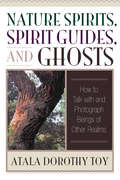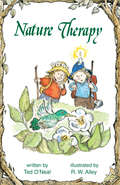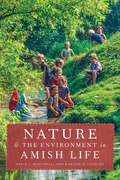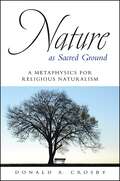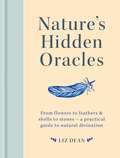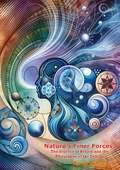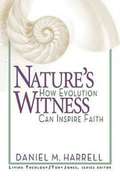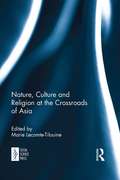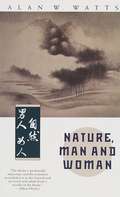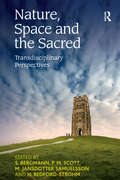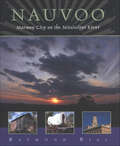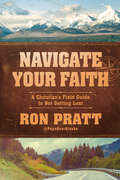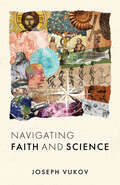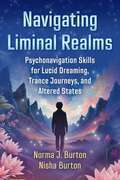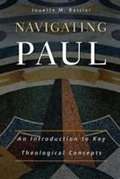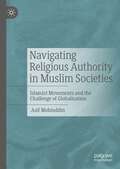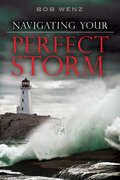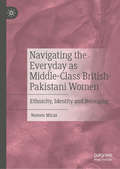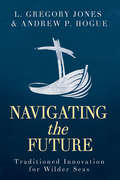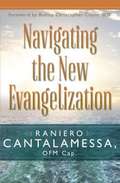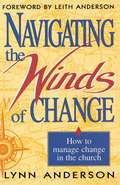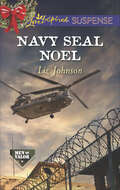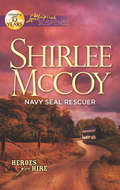- Table View
- List View
Nature Spirits, Spirit Guides, and Ghosts
by Atala Dorothy ToyBoulders laugh, trees talk, and practically each patch of ground has meaning, in Atala Toy's experience. Faeries, angels, ghosts, orbs, and spirits of place are just some of the life forms with which she helps us attune-and shows us how to record their image! Readers will cherish her rare combination of esoteric wisdom and practical guidance. With substantive clarity, she explains time travel, portals, dowsing, negative and positive vortexes, balls of energy known as merkabahs, ley lines, and orbs-the plasma of some life form visible to human eyes or to cameras, many of which are nature spirits who enjoy being around happy energy and so are often seen at parties and spiritual gatherings.A professional interdimensional communicator, Atala is up to the minute in her understanding of the emerging field of spiritual sciences and the correlations between modern physics and ancient metaphysical traditions that perceive the oneness of all nature. We all communicate interdimensionally every day, she says. We just don't know it, and so we lose out on the many ways to receive help from the other life forms who share our space. Drawing on her own and her clients' experiences, she teaches through colorful stories and her own powerful photographs. Titles include "The Ghost Who Washed Dishes," "The Haunted Hotel," "The Guardian of the Spring," "The Horse Who Knew More Than His Owners," "The Jilted House," "The Stranded Gnome," "The Moss Faery," "The Owl on Turtle Island," and "The Balsam Who Loved the Birch." She also includes lessons explaining the energetic principles of the situation; simple exercises for mastering the principle contained in the story; and tips for photographing other life forms using technology available to anyone, such as digital or even cell phone cameras. By entering the fascinating realm of this book, the reader will join the growing number of people aware of subtle energy and able to see through the veils between dimensions. Not only is this possibility personally enriching, it serves a broader purpose as well. Needless to say, the planet and everything on it is at a critical juncture. In damaging the earth, we have damaged the nature beings' home as well. It is therefore strongly in their interest to assist us in transforming the earth into something better. This book shows us how to learn from and enjoy them in a most delightful way
Nature Therapy
by R. W. Alley Ted O'NealNature heals. This little book of Nature Therapy shows just how all of creation--by delighting and inspiring us, by teaching us, by feeding and providing for us, and, finally by engaging us--does its therapeutic good work on our weary or broken or over-stressed selves.
Nature and Supernature (St. Michael's Lectures #Vol. 1973)
by E. L. MascallIn the fall of 1972, St. Michael’s Jesuit School of Philosophy and Letters at Gonzaga University inaugurated the St. Michael’s Lectures as a forum for outstanding international scholars to examine the question of God in modern thought. The theme for the lecture series is much the same as that of the famous Gifford Lectures, but the approach is not only philosophical but also theological. <p><p>The uniqueness lies primarily in the dynamic inherent in the structure of the series. A lecture in a tripartite form (over a three-day period) is given each fall. As the series unfolds, each lecturer is to enter into dialogue with the immediately preceding lecturer and, to the extent that he wishes, he may respond to other former lecturers in the series. At the same time, each expands the discussion by his or her own creative contribution. As a result there will develop an ongoing exchange among thinkers of international reputation.
Nature and the Environment in Amish Life (Young Center Books in Anabaptist and Pietist Studies)
by David L. McConnell Marilyn D. LovelessThe Amish relationship to the environment is much more complicated than you might think.The pastoral image of Amish communities living simply and in touch with the land strikes a deep chord with many Americans. Environmentalists have lauded the Amish as iconic models for a way of life that is local, self-sufficient, and in harmony with nature. But the Amish themselves do not always embrace their ecological reputation, and critics have long questioned the portrayal of the Amish as models of environmental stewardship.In Nature and the Environment in Amish Life, David L. McConnell and Marilyn D. Loveless examine how this prevailing notion of the environmentally conscious Amish fits with the changing realities of their lives. Drawing on 150 interviews conducted over the course of 7 years, as well as a survey of household resource use among Amish and non-Amish people, they explore how the Amish understand nature in their daily lives and how their actions impact the natural world. Arguing that there is considerable diversity in Amish engagements with nature at home, at school, at work, and outdoors, McConnell and Loveless show how the Amish response to regional and global environmental issues, such as watershed pollution and climate change, reveals their deep skepticism of environmentalists. They also demonstrate that Amish households are not uniformly lower in resource use compared to their rural, non-Amish neighbors, though aspects of their home economy are relatively self-sufficient.The first comprehensive study of Amish understandings of the natural world, this compelling book complicates the image of the Amish and provides a more realistic understanding of the Amish relationship with the environment.
Nature as Sacred Ground: A Metaphysics for Religious Naturalism
by Donald A. CrosbyNature as Sacred Ground explores a metaphysics for religious naturalism. Donald A. Crosby discusses major aspects of reality implicit in his ongoing explication of Religion of Nature, a religious outlook that holds the natural world to be the only world, one with no supernatural domains, presences, or powers behind it. Nature as thus envisioned is far more than just a system of facts and factual relations. It also has profoundly important valuative dimensions, including what Crosby regards as nature's intrinsically sacred value. The search for comprehensive metaphysical clarity and understanding is a substantial part of this work's undertaking. Yet this endeavor also reminds us that, while it is good to think deeply and systematically about major features of reality and their relations to one another, we also need to reflect tirelessly about how to respond to metaphysical concepts that call for decision and action.
Nature''s Hidden Oracles: From Flowers to Feathers & Shells to Stones - A Practical Guide to Natural Divination
by Liz DeanNature''s Hidden Oracles is a practical manual for natural divination in the outdoor environment all year round.By collecting and interacting with the objects you find outside, you can generate new ways of seeing and become more mindful of our environment and what it has to say about our past, present and future. Nature''s Hidden Oracles shows you how to connect with your surroundings and the ways of our ancestors through practices such as flower divination, herb-scrying and listening to the oracles of the stones and trees that surround us.Chapters Include: 1 Oracles of the trees: Leaf, bark & branch2 Flower divination: Petal predictions3 Herb scrying: Sensory messengers4 Oracles of stone: Rocks, pebbles & witch stones5 Natural charms: Beach, field & forest
Nature's Finer Forces: Translated From The Sanskrit, With Introductory And Explanatory Essays On Nature's Finer Forces (classic Reprint)
by Rama PrasadExplore the profound intersection of ancient wisdom and modern science with Rama Prasad's Nature's Finer Forces: The Science of Breath and the Philosophy of the Tattvas. This enlightening work delves into the intricate philosophies and practices that underlie the ancient Indian understanding of the natural forces, or Tattvas, and their connection to the science of breath.Rama Prasad, an esteemed scholar of Hindu philosophy and metaphysics, presents a comprehensive study of the Tattvas—elemental principles that constitute the fabric of the universe according to traditional Indian thought. Through clear and articulate prose, Prasad explains how these fundamental forces govern both the macrocosm of the universe and the microcosm of the human body.Nature's Finer Forces provides an in-depth exploration of Pranayama, the ancient practice of breath control, and its pivotal role in harmonizing the Tattvas within the human system. Prasad meticulously outlines the techniques and benefits of various breathing exercises, emphasizing their importance for physical health, mental clarity, and spiritual awakening. His detailed explanations offer practical guidance for incorporating these practices into daily life.Nature's Finer Forces is an essential read for yoga practitioners, spiritual seekers, and anyone interested in the holistic science of breath and the elemental forces that shape our existence. Rama Prasad’s erudite and engaging exposition invites readers to deepen their understanding of themselves and the universe, fostering a greater sense of balance, harmony, and inner peace.Join Rama Prasad on a journey into the subtler dimensions of nature and the self, and discover the timeless wisdom of the Tattvas and the transformative power of breath.
Nature's Hidden Oracles: From Flowers to Feathers & Shells to Stones - A Practical Guide to Natural Divination
by Liz DeanNature's Hidden Oracles is a practical manual for natural divination in the outdoor environment all year round.By collecting and interacting with the objects you find outside, you can generate new ways of seeing and become more mindful of our environment and what it has to say about our past, present and future. Nature's Hidden Oracles shows you how to connect with your surroundings and the ways of our ancestors through practices such as flower divination, herb-scrying and listening to the oracles of the stones and trees that surround us.Chapters Include: 1 Oracles of the trees: Leaf, bark & branch2 Flower divination: Petal predictions3 Herb scrying: Sensory messengers4 Oracles of stone: Rocks, pebbles & witch stones5 Natural charms: Beach, field & forest
Nature's Witness: How Evolution Can Inspire Faith (Living Theology)
by Daniel M. HarrellPeople of faith insist that God is the God of the world around us. Yet scientific evidence supporting evolution seems to offer an explanation of reality different from the biblical one. In light of this apparent conflict, some choose either to deny the scientific data or separate science and faith from each other, giving the appearance that faith is disconnected from reality. Others accommodate faith to science, but run the risk of watering down faith such that faith "fills in the blanks" left by science. Against these options, Daniel Harrell asserts that the evidence for evolution accurately describes the world we see, but insists that this description does not adequately serve as an explanation for the world. Rather than seeing science and faith as diametrically opposed, Harrell suggests that evolutionary data actually opens the door for deeper theological reflection on God’s creation. Writing out of a pastoral concern for those struggling to negotiate faith and evolution, Harrell argues that being reliable witnesses to creation helps people of faith be reliable witnesses to its creator. Whether they are pastors wondering how to talk about these issues with their congregations, or students asking whether their biology classes make their faith irrelevant, Harrell’s readers are winsomely led on a journey of exploration in which a robust biblical faith can be held along with affirmation of the scientific data for evolution.
Nature, Culture and Religion at the Crossroads of Asia (Social Science Press Ser.)
by Marie Lecomte-TilouineThis book explores how ethnic groups living in the Himalayan regions understand nature and culture. The first part addresses the opposition between nature and culture in Asia’s major religious traditions such as Hinduism, Buddhism, Islam and Shamanism. The second part brings together specialists of different representative groups living in the heterogeneous Himalayan region. They examine how these indigenous groups perceive their world. This includes understanding their mythic past, in particular, the place of animals and spirits in the world of humans as they see it and the role of ritual in the everyday lives of these people. The book takes into account how these various perceptions of the Himalayan peoples are shaped by a globalized world. The volume thus provides new ways of viewing the relationship between humans and their environment.
Nature, Man and Woman
by Alan W. WattsA provocative and enduring work that reexamines humanity's place in the natural world -- and the spirit's relation to the flesh -- in the light of Chinese Taoism.That human beings stand separate from a nature that must be controlled, that the mind is somehow superior to the body, and that all sexuality entails a seduction -- a danger and a problem-are all assumptions upon which much of Western thought and culture is based. And all of them in some way underlie our exploitation of the earth, our distrust of emotion, and our loneliness and reluctance to love.Few books have challenged those assumptions as directly as this erudite and engaging work by the author of The Way of Zen. Drawing on the precepts of Taoism, Alan Watts offers an alternative vision of man and the universe -- one in which the distinctions between self and other, spirit and matter give way to a more holistic way of seeing. Nature, Man and Woman is a book of great elegance and far-reaching implication -- one of those rare texts that can change the way we think, feel, and love.
Nature, Space and the Sacred: Transdisciplinary Perspectives
by S. Bergmann H. Bedford-StrohmNature, Space and the Sacred offers the first investigative mapping of a new and highly significant agenda: the spatial interactions between religion, nature and culture. In this ground-breaking work, different concepts of religion, theology, space and place and their internal relations are discussed in an impressive range of approaches. Weaving together a diversity of perspectives, this book presents an innovative and truly transdisciplinary environmental science. Its broad range offers a rich exchange of insights, methods and theoretical engagements.
Nauvoo: Mormon City on the Mississippi River
by Raymond BialIn 1839, persecuted Mormons fled Missouri, across the Mississippi River, seeking freedom from violence. They hoped to find a safe haven on the banks of the river in an Illinois city that they called Nauvoo, “the city beautiful.”The Mormons did not flourish for long in Nauvoo. In neighboring cities some grew resentful of the prosperity that Joseph Smith and his people were enjoying. Religious misconceptions further fueled hostility toward the Mormons. Would the oft-persecuted Mormons have to flee their city beautiful?Through poignant writing and photographs of Nauvoo today, Raymond Bial tells the story of the city that many Mormons consider to be the wellspring of their religion.
Navigate Your Faith: A Christian's Field Guide to Not Getting Lost
by Ron PrattWhat's the point of being a Christian anymore? Many Christians today are feeling unfulfilled in their walk with God, and they have no idea it&’s because of the little decisions they&’re making each day that are leading them into lives of compromise. In Navigate Your Faith Ron Pratt uses a fictional American family to expose how the enemy lures believers into prioritizing their own pleasure, entertainment, or career goals over their relationship with Christ. This erodes their passion for Jesus and causes them to become spiritually bored and have powerless Christian lives. Rather than claiming that God will approve of Christians no matter what they do, as some modern ministers do, Navigate Your Faith challenges readers to take a hard look at their lives and see if they&’re simply incorporating Jesus into their lifestyles or allowing Him to set them on a course of His choosing. With proven strategies to rebuild lost intimacy with God, this book will help Christians recognize the deceptive tactics of the enemy, break out of complacency, and make a greater impact on the world around them.This book will help you recognize and avoid the deception of today's nominal Christian culture.
Navigating Faith and Science
by Joseph VukovReligious belief is often perceived as being in conflict with science—but does it have to be? Not usually, says Joseph Vukov. In this short, accessible guide, Vukov advances three models for Christians to utilize when navigating the relationship between science and faith: conflict, independence, and dialogue. He argues that dialogue is the ideal model to follow most of the time—but not necessarily all the time. Through a philosophical approach grounded in compelling real-world examples, Vukov shows how no single model can be universally adequate, and how Christians must proceed with discernment according to the nature of the matter at hand. Considering a wide variety of illustrative issues—including cosmology, evolutionary biology, extraterrestrial life, miracles, brain death, and theoretical physics—Vukov introduces and describes each of the three models of interaction between faith and science, surveys their applications, and evaluates the effectiveness of each. Throughout, he encourages Christians to embrace a spirit of intellectual humility and remember that, at their best, faith and science converge in their relentless human pursuit of truth.
Navigating Liminal Realms: Psychonavigation Skills for Lucid Dreaming, Trance Journeys, and Altered States
by Norma J. Burton Nisha Burton• Investigates drumming-induced trance states through shamanic journeying• Provides advanced lucid dreaming training, sharing techniques for inducing lucidity and skillfully navigating our inner cosmos• Explores the mindful use of psychedelics, offering guidance on setting intention, navigating the experience, and integrating insightsOFFERING TECHNIQUES from psychonauts ancient and modern, this profound guide helps you navigate consciously into the depths of the human psyche. Psychonavigation is the art of mindfully exploring the liminal realms of consciousness. This requires a map, a guide, and a clear intent, so one does not emerge overwhelmed and struggling with unexpected shadow material.Norma and Nisha Burton map the important connection between three gateways into the psyche&’s depths: lucid dreaming, shamanic drumming trance journeys, and ceremonial plant medicine journeys. With drumming-induced trance journeys, they explore the scientific effect on brainwave frequencies alongside consciousness teachings from indigenous cultures like the Sami of Norway and Huichol of Mexico. Their masterful approach to lucid dreaming transcends basic instruction, offering sophisticated techniques to not only summon but sustain lucidity and integrate suppressed parts of oneself. They explain how a mindful engagement with entheogens can be profoundly enhanced through these precursory mystical practices, creating a safe container for integration and meaning-making that honors the gravity of such experiences.With these skillful methodologies, ancient psycho-spiritual techniques meet ultra-current science to enable seekers to process and integrate profound encounters with expanded consciousness.
Navigating Paul: An Introduction to Key Theological Concepts
by Jouette M. BasslerJouette Bassler, one of the foremost experts on Pauline theology, offers her wisdom and insight into the core of Paul's thought in this brief and accessible book. She focuses on major themes in Paul, such as grace, law, faith, righteousness, Israel, resurrection, and what it means to be "in Christ. " Through each of these themes, she explores the wealth of Paul's various writings, lifting up the most important and basic of Paul's ideas and explaining them within the context of the ancient Greco-Roman world.
Navigating Religious Authority in Muslim Societies: Islamist Movements and the Challenge of Globalisation
by Asif MohiuddinGlobalisation stands as an indispensable lens through which to analyse current cultural, political, and social transformations. This prevailing paradigm, acknowledged by its advocates and critics, profoundly shapes our environment. Within this global landscape, Islam's position is noteworthy—often perceived as rejecting globalisation and its secular underpinnings. This book offers a perspective of the global resurgence of religion in general and the revival of Islam in particular as crucial features of globalisation. Furthermore, the book deeply explores how Islamist groups strategically challenge religious authority, utilising social media and the internet to reshape their spheres of influence. By exploring these dynamics, the book aims to provide comprehensive insights into the interplay between Islamist strategies, digital platforms, and religious institutions within our interconnected world.
Navigating Your Perfect Storm
by Bob WenzNavigating Your Perfect StormNavigating Your Perfect Storm
Navigating the Everyday as Middle-Class British-Pakistani Women: Ethnicity, Identity and Belonging
by Noreen MirzaThis ethnographic study of middle-class British-Pakistani women in Manchester explores the sense of belonging they create through recognition and social status. Belonging in these communities is enacted through the performance of different identities—class, ethnicity, nationality, generation, age, religion, and gender—that earn them social power and status among family and friends. To prove they are “model migrants,” worthy of respect and recognition, these women perform various and intersecting identities to maximize status and social capital in diverse situations. Far from being passive victims of racial, religious, or cultural discrimination, middle-class British-Pakistani women challenge prejudice against Muslims and British-Pakistanis through certain practices, objects, performances, and relationships, serving as ambassadors for their religious and ethnic identity through their conduct and interaction with others in daily life.
Navigating the Future: Traditioned Innovation for Wilder Seas
by Andrew P. Hogue Dr L. Gregory JonesTraditioned innovation is a habit of being and living that cultivates a certain kind of moral imagination shaped by storytelling and expressed in creative, transformational action. Moral imagination is about character, which depends on ongoing formation that takes place in friendships and communities that embody traditions and that are sustained by institutions.There is no quick-fix or set of techniques that will create a mindset of traditioned innovation. But we do believe that you can learn to cultivate it by Becoming immersed in an imaginative engagement with the story of God told through Scripture Learning from exemplary institutions, communities, and people practicing traditioned innovation. Discovering new skills for integrating character formation and dense networks of friendships, communities and institutions into your leadership and life.Navigating the Future will explore stories and tips for cultivating traditioned innovation that will stimulate your thinking and inspire your imagination for more faithful and fruitful living along with the cultivation of more vibrant, life-giving institutions.
Navigating the New Evangelization
by Raniero Cantalamessa Christopher J. Coyne BishopCompiling meditations he delivered at the Papal Household, Fr. Cantalamessa traces the waves of evangelization from the first centuries of Christianity to the present day, navigating through the major modern challenges that the announcement of the Gospel encounters: scientific atheism, rationalism, and secularism.
Navigating the Winds of Change
by Lynn AndersonHow can your church manage cultural change without compromising eternal truths? Many churches are currently grappling with this question, and this important book by Lynn Anderson is full of answers. The winds of change are blowing, and they cannot be ignored. Churches that learn how to successfully manage the changes these winds bring will sail smoothly into the 21st century. Congregations that close their eyes to the reality of change will be swept off course or into extinction. In this book, Anderson -- a well-known author, minister, and leader -- presents a wealth of practical, effective strategies for managing change in the church. He is the creative force behind the annual "Church That Connects" seminar that has helped hundreds of church leaders manage positive change in their congregations, and now he gives these vital strategies directly to you.
Navy SEAL Noel: The Yuletide Rescue Navy Seal Noel Treacherous Intent (Men of Valor)
by Liz JohnsonCaught in the grip of deadly criminals, a scientist puts her holiday hopes on the man who broke her heart in this Christmas season romantic suspense.Abducted by a drug cartel, scientist Jessalynn McCoy has been given a simple choice: either produce a deadly toxin or be killed. Trapped and desperate, she gets help from the last person she’d ever expect it from. Years ago, Will Gumble was the boy who let her down. Now that he’s a navy SEAL, Jessalynn trusts his skills and experience. Yet trusting him is still a struggle. Determined to redeem himself in Jessalynn’s eyes, Will’s Christmas wish is to heal their damaged relationship and get her back to safety. But as time runs out and the stakes keep rising, he’ll need a miracle to keep them both alive.
Navy SEAL Rescuer
by Shirlee MccoyAfter four years in prison for crimes she didn't commit, Catherine Miller just wants to lie low at her isolated farmhouse. But someone still thinks she's guilty-and should pay the ultimate price. Someone angry enough to spray-paint murderer on her home and attack her in broad daylight. Her neighbor, former navy SEAL Darius Osborne, vows to hunt down her predator. The handsome security contractor has as harrowing a past as Catherine's, and won't let anyone get too close. Yet with a cold-blooded killer on her trail, they'll get closer than either ever imagined.
